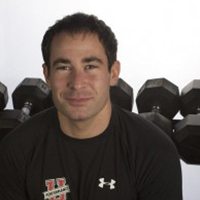1. The Best Core Exercises Aren't "Core" Exercises
A staple principle of good weight training is to emphasize compound (multi-joint) exercises and to supplement those movements with isolation (single joint) exercises.
Interestingly, it's rare to see the principle of compound movements utilized when it comes to training the core. Many of the most popular and commonly use core exercises are isolation.
However, a 2013 study published in the Journal of Strength & Conditioning Research sought to determine whether integration (i.e. compound) core exercises that require activation of the distal (away from the center of the body) trunk muscles (deltoid and gluteal) elicit greater activation of primary trunk muscles. This was in comparison to isolation core exercises that only require activation of the proximal trunk muscles.
The results of this study indicate that the activation of the abdominal and lumbar muscles was the greatest during the exercises that required deltoid and gluteal recruitment.
The researchers of this study concluded that, "An integrated routine that incorporates the activation of distal trunk musculature would be optimal in terms of maximizing strength, improving endurance, enhancing stability, reducing injury, and maintaining mobility."
In other words, a comprehensive core training routine, like every other muscle group, should emphasize compound exercises and supplement those with some targeted (i.e., isolation) moves as well.
Speaking of "Compound Core Training" exercises; in the video below I highlight some of the biggest contradictions smart personal trainers make when it comes to using core training in their program.
2. The Core Isn't Just Your Abs and Low Back
Although the research covered above is very recent, the idea of training our core with compound movements is not at all a new concept.
In fact, the term "The Core" was first coined in 1982 by Bob Gajda (1966 Mr. America) & Richard Dominquez M.D. in their book Total Body Training.
In their book, Gajda and Dominquez stated, "The foundation of Total Body Training is the core, which compromises the muscles in the center of the body. These muscles stabilize the body while in upright, antigravity position or while using the arms and legs to throw or kick. These muscles maintain the body's structure during vigorous exercises such as running, jumping, shoveling and lifting weights. These muscles also control the head, neck, ribs, spine and pelvis"
Contrary to popular misconception, the "core" is not just your abs and lower back; it's all of your torso muscles (shoulders, glutes, abs, mid-back, lats, etc.) minus your arms and legs.
3. "Functional" Anatomy: Your Abs DO Flex Your Spine When Standing Upright!
I can't tell you how many times over the last 10+years I've witnessed very smart personal trainers - who consider themselves "Functional training" specialists - talk about how the abdominals don't flex the spine from a standing upright position. These trainers use this example (which I display in the video below) to actively demonstrate their claim that your abdominals don't function to flex your spine when you're in a standing position, therefore making floor based exercises "non-functional."
Unfortunately, as I clearly demonstrate in this video below, this well-intentioned demonstration, although not completely inaccurate, is very misleading as it leaves out a very important element, which occurs in all sports (and often in normal life), that directly effects how your abdominals function from an upright position.
When doing things like changing direction, or changing your level (like to duck a punch), or when slamming a sledge hammer downward, etc., your abdominals are indeed flexing your spine from an upright position.
Don't get it twisted, as this is not to say that all you need to get a "functionally" strong core is to bang out a bunch of crunches. Not in the least, as 1) that would be ridiculous and 2) it would completely contradict what I just covered above in #1 & 2. But it is to clarify that it's wrong to make blanket proclamations that using some trunk flexion exercises can't (or won't) help you functional from a standing position because there's a good chance it can via the S.A.I.D principle.
Now, I'm well-aware of what a polarizing issue trunk flexion exercises have become in the professional fitness training field, which is why I won't bother attempting to convince you to take "our side", as my feeling is to "train and let train." So, all I can do is share the Performance U perspective on this issue, which is as follows:
Based on all of the available evidence - not just blindly following blanket statements from a few dogmatic strength coaches or cherry-picking a few bits of Dr.Stuart McGill's work - which Bret Contreras and Brad Schoenfeld did a great job a summarizing in this paper; considering that each training situation is as unique as the individuals who we are training, along with using our own critical thinking abilities; we see no reason to feel that incorporating some supplemental trunk flexion exercises - done in a pain-free manner and avoiding end-ranges of motion - when we feel it appropriate, is inherently "dangerous."
In other words, we just don't see - when considering all of the available evidence - how anyone can confidently pontificate about trunk flexion exercises in black and white terminologies (i.e., "bad" or "good") as some coaches do.
That said, we certainly don't feel this type of training should be an emphasis - over more integrated (compound) core oriented training - in any type of training program.
To narrow it down to one application: Our favorite "go-to" trunk flexion based exercise is the Pike Roll Out -
Final Words
You certainly don't have to agree with everything I've shared in this article, as no one here is trying to tell you what you should or should not be doing. So, instead of getting caught up with arguing over what you agree with and what you don't, I recommend you ask yourself this simple question: "Will it lead to my benefit?"
If "no," reject it and move on. If "yes," absorb it and cultivate it by experimenting with its various applications until you've adapted and modified it into something that is your own creation and usable for your own benefit.
In other words, as the great Bruce Lee said, "absorb what is useful, reject what is useless and add what is specifically your own, then walk on...."
Core Training: Facts, Fallacies, and Top Techniques
Core training is one of the hottest subjects in the fitness field and getting a good core is one of the most common goals you'll encounter. Yet, it's also one of the most misunderstood areas of fitness with conflicting information rampent.











